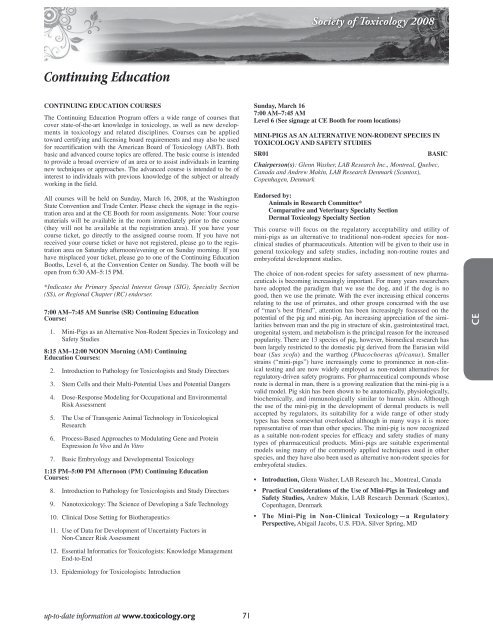Annual Meeting Program - Society of Toxicology
Annual Meeting Program - Society of Toxicology
Annual Meeting Program - Society of Toxicology
You also want an ePaper? Increase the reach of your titles
YUMPU automatically turns print PDFs into web optimized ePapers that Google loves.
<strong>Society</strong> <strong>of</strong> <strong>Toxicology</strong> 2008<br />
Continuing Education<br />
Continuing Education Courses<br />
The Continuing Education <strong>Program</strong> <strong>of</strong>fers a wide range <strong>of</strong> courses that<br />
cover state-<strong>of</strong>-the-art knowledge in toxicology, as well as new developments<br />
in toxicology and related disciplines. Courses can be applied<br />
toward certifying and licensing board requirements and may also be used<br />
for recertification with the American Board <strong>of</strong> <strong>Toxicology</strong> (ABT). Both<br />
basic and advanced course topics are <strong>of</strong>fered. The basic course is intended<br />
to provide a broad overview <strong>of</strong> an area or to assist individuals in learning<br />
new techniques or approaches. The advanced course is intended to be <strong>of</strong><br />
interest to individuals with previous knowledge <strong>of</strong> the subject or already<br />
working in the field.<br />
All courses will be held on Sunday, March 16, 2008, at the Washington<br />
State Convention and Trade Center. Please check the signage in the registration<br />
area and at the CE Booth for room assignments. Note: Your course<br />
materials will be available in the room immediately prior to the course<br />
(they will not be available at the registration area). If you have your<br />
course ticket, go directly to the assigned course room. If you have not<br />
received your course ticket or have not registered, please go to the registration<br />
area on Saturday afternoon/evening or on Sunday morning. If you<br />
have misplaced your ticket, please go to one <strong>of</strong> the Continuing Education<br />
Booths, Level 6, at the Convention Center on Sunday. The booth will be<br />
open from 6:30 AM–5:15 PM.<br />
*Indicates the Primary Special Interest Group (SIG), Specialty Section<br />
(SS), or Regional Chapter (RC) endorser.<br />
7:00 AM–7:45 AM Sunrise (SR) Continuing Education<br />
Course:<br />
1. Mini-Pigs as an Alternative Non-Rodent Species in <strong>Toxicology</strong> and<br />
Safety Studies<br />
8:15 AM–12:00 NOON Morning (AM) Continuing<br />
Education Courses:<br />
2. Introduction to Pathology for Toxicologists and Study Directors<br />
3. Stem Cells and their Multi-Potential Uses and Potential Dangers<br />
4. Dose-Response Modeling for Occupational and Environmental<br />
Risk Assessment<br />
5. The Use <strong>of</strong> Transgenic Animal Technology in Toxicological<br />
Research<br />
6. Process-Based Approaches to Modulating Gene and Protein<br />
Expression In Vivo and In Vitro<br />
7. Basic Embryology and Developmental <strong>Toxicology</strong><br />
1:15 PM–5:00 PM Afternoon (PM) Continuing Education<br />
Courses:<br />
8. Introduction to Pathology for Toxicologists and Study Directors<br />
9. Nanotoxicology: The Science <strong>of</strong> Developing a Safe Technology<br />
10. Clinical Dose Setting for Biotherapeutics<br />
11. Use <strong>of</strong> Data for Development <strong>of</strong> Uncertainty Factors in<br />
Non-Cancer Risk Assessment<br />
Sunday, March 16<br />
7:00 AM–7:45 AM<br />
Level 6 (See signage at CE Booth for room locations)<br />
Mini-Pigs As an Alternative Non-Rodent Species in<br />
<strong>Toxicology</strong> and Safety Studies<br />
SR01<br />
Basic<br />
Chairperson(s): Glenn Washer, LAB Research Inc., Montreal, Quebec,<br />
Canada and Andrew Makin, LAB Research Denmark (Scantox),<br />
Copenhagen, Denmark<br />
Endorsed by:<br />
Animals in Research Committee*<br />
Comparative and Veterinary Specialty Section<br />
Dermal <strong>Toxicology</strong> Specialty Section<br />
This course will focus on the regulatory acceptability and utility <strong>of</strong><br />
mini-pigs as an alternative to traditional non-rodent species for nonclinical<br />
studies <strong>of</strong> pharmaceuticals. Attention will be given to their use in<br />
general toxicology and safety studies, including non-routine routes and<br />
embry<strong>of</strong>etal development studies.<br />
The choice <strong>of</strong> non-rodent species for safety assessment <strong>of</strong> new pharmaceuticals<br />
is becoming increasingly important. For many years researchers<br />
have adopted the paradigm that we use the dog, and if the dog is no<br />
good, then we use the primate. With the ever increasing ethical concerns<br />
relating to the use <strong>of</strong> primates, and other groups concerned with the use<br />
<strong>of</strong> “man’s best friend”, attention has been increasingly focussed on the<br />
potential <strong>of</strong> the pig and mini-pig. An increasing appreciation <strong>of</strong> the similarities<br />
between man and the pig in structure <strong>of</strong> skin, gastrointestinal tract,<br />
urogenital system, and metabolism is the principal reason for the increased<br />
popularity. There are 13 species <strong>of</strong> pig, however, biomedical research has<br />
been largely restricted to the domestic pig derived from the Eurasian wild<br />
boar (Sus sc<strong>of</strong>a) and the warthog (Phacochoerus africanus). Smaller<br />
strains (“mini-pigs”) have increasingly come to prominence in non-clinical<br />
testing and are now widely employed as non-rodent alternatives for<br />
regulatory-driven safety programs. For pharmaceutical compounds whose<br />
route is dermal in man, there is a growing realization that the mini-pig is a<br />
valid model. Pig skin has been shown to be anatomically, physiologically,<br />
biochemically, and immunologically similar to human skin. Although<br />
the use <strong>of</strong> the mini-pig in the development <strong>of</strong> dermal products is well<br />
accepted by regulators, its suitability for a wide range <strong>of</strong> other study<br />
types has been somewhat overlooked although in many ways it is more<br />
representative <strong>of</strong> man than other species. The mini-pig is now recognized<br />
as a suitable non-rodent species for efficacy and safety studies <strong>of</strong> many<br />
types <strong>of</strong> pharmaceutical products. Mini-pigs are suitable experimental<br />
models using many <strong>of</strong> the commonly applied techniques used in other<br />
species, and they have also been used as alternative non-rodent species for<br />
embry<strong>of</strong>etal studies.<br />
• Introduction, Glenn Washer, LAB Research Inc., Montreal, Canada<br />
• Practical Considerations <strong>of</strong> the Use <strong>of</strong> Mini-Pigs in <strong>Toxicology</strong> and<br />
Safety Studies, Andrew Makin, LAB Research Denmark (Scantox),<br />
Copenhagen, Denmark<br />
• The Mini-Pig in Non-Clinical <strong>Toxicology</strong>—a Regulatory<br />
Perspective, Abigail Jacobs, U.S. FDA, Silver Spring, MD<br />
CE<br />
12. Essential Informatics for Toxicologists: Knowledge Management<br />
End-to-End<br />
13. Epidemiology for Toxicologists: Introduction<br />
up-to-date information at www.toxicology.org 71
















